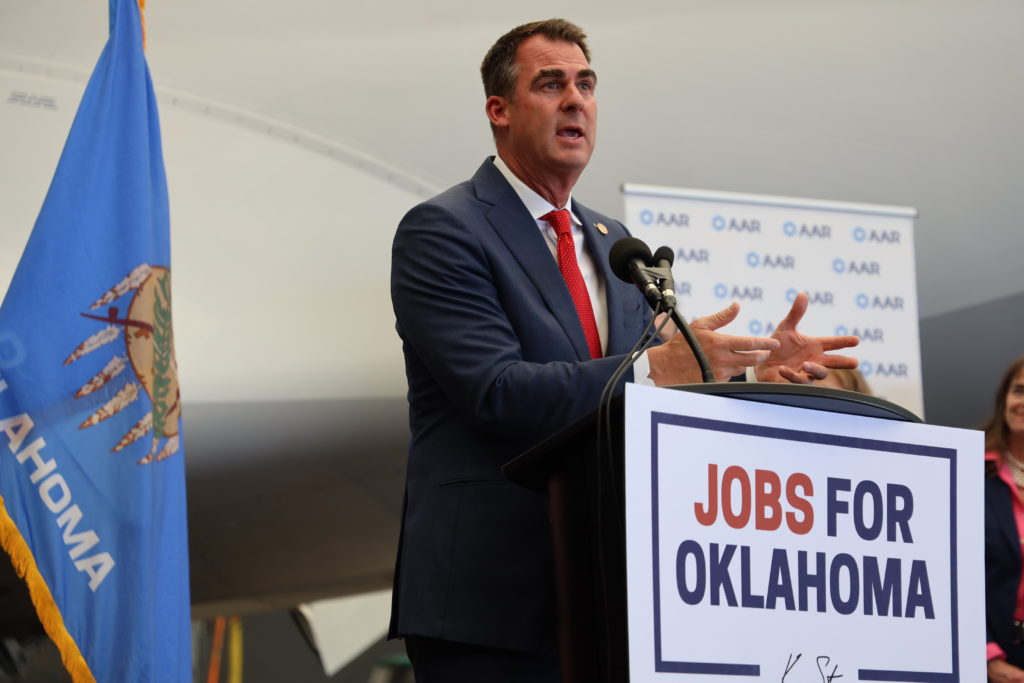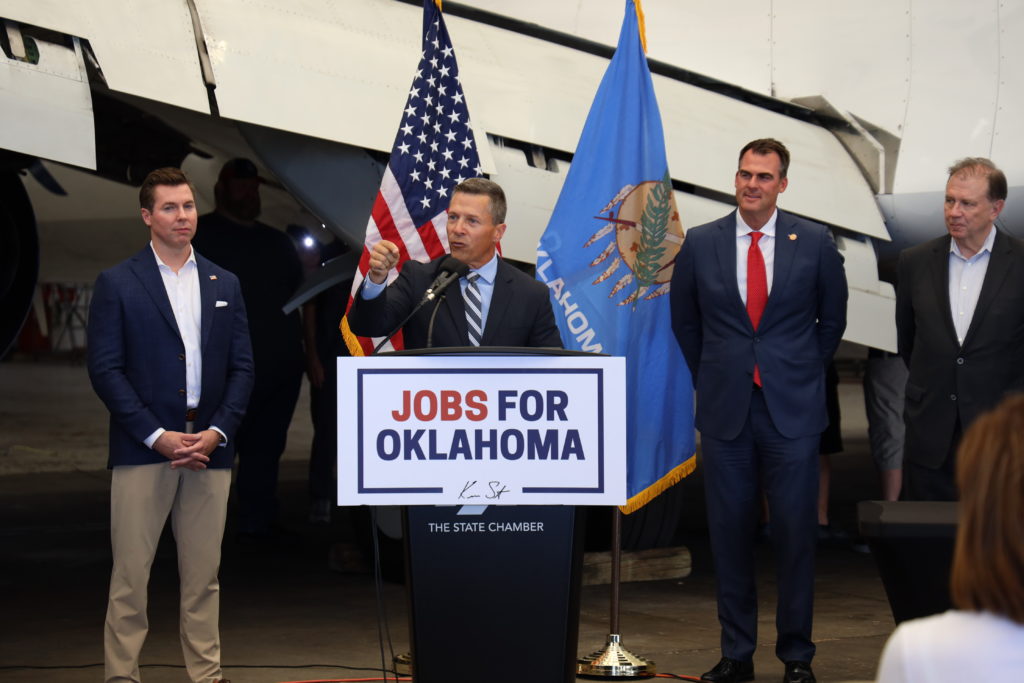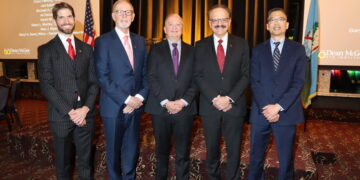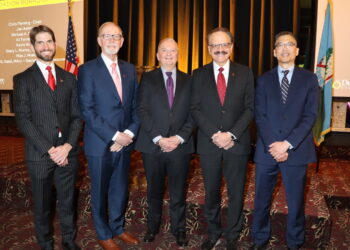OKLAHOMA CITY (OBV) – State leaders gathered Wednesday and celebrated the forthcoming creation of the Oklahoma Workforce Commission with a ceremonial signing of the legislation that establishes the commission.
Gov. Kevin Stitt signed a ceremonial copy of Senate Bill 621 during the event at the AAR Aircraft Services hangar at Will Rogers World Airport, a primary hub of Oklahoma’s burgeoning aerospace industry. He officially signed the bill into law last week, two weeks after it fully passed the Oklahoma State Legislature.
“It is a super exciting day for me and all of us up here and really for the business community,” Stitt said prior to signing the legislation into law. “As we’re recruiting companies, we hear over and over and over again that it’s all about workforce; [they ask if] they can get the workers that they need.”

The State Chamber of Oklahoma hosted the ceremony. Chad Warmington, president and CEO of The State Chamber of Oklahoma, was a leading advocate of the bill, championing the effort to create the Oklahoma Workforce Commission. Warmington, along with Oklahoma legislators and business leaders, were at the ceremony. Warmington, Stitt, and SB 621 authors Sen. Adam Pugh, R-Edmond, and Sen. Brian Hill, R-Mustang, each spoke about the significance of the bill and the extensive work toward its creation before the ceremonial signing.
“This is a big day for the business community and for the state of Oklahoma. For years, workforce has been the number one problem for state companies. We worked for over two years to research and develop a workforce transformation plan,” Warmington said. “The Workforce Commission will make it easier for existing companies to grow and it will create the skilled workforce we need to attract new businesses to our state. We thank all our members and lawmakers that have worked so hard to make this day a reality.”
Pugh said it is fitting that the bill was signed in a workspace that is part of Oklahoma’s fastest growing industry: aerospace. He stressed the urgent need to create an Oklahoma Workforce Commission, saying that workforce is vital to national security.
“You think about our industries that are growing in Oklahoma – aerospace and defense, biotech, health care, energy independence – those are national security industries that are vital to the future of the United States, both domestically as well as abroad,” Pugh said.
Pugh proceeded to cite State Chamber research, which found that workforce is the paramount concern among business leaders.
“More than 53 percent of all businesses across the United States have said they do not believe that there is an adequate workforce to meet the needs of a 21st century economy in a tight labor market where there is need for skills that are stackable and have to reinvent themselves less than every decade,” Pugh said.

Oklahoma has a 3 percent unemployment rate; unemployment routinely stays below 4 percent, but thousands of jobs across Oklahoma remain open each month. Oklahoma’s labor participation rate – the percentage of working-age Oklahomans actively participating in the workforce – was at 61.1 percent in April, which ranks in the bottom half among states.
SB 621 was born from research which revealed a workforce deficiency in Oklahoma. A State Chamber and Business Roundtable joint survey found that 60 percent of Oklahoma’s business community said workforce shortages were the number one threat to business growth and expansion. Warmington and Ben Lepak, executive director of the State Chamber Research Foundation, provided Stitt and legislators research data which showed that Oklahoma was 36,000 workers deficient in filling available jobs.
“So, you begin to address that really through a number of different means,” Warmington said. “You really got to address the supply. We got to get more people to Oklahoma and then we got to address the demand side, too.”
It was determined that a new, focused workforce management system was needed to grow the state’s workforce and fill the thousands upon thousands of available jobs.
“What we learned very quickly was there’s a lot of good people in Oklahoma doing good work on workforce, but there was no collaboration or coordination between those entities,” Warmington said. “There was none. No one owner of workforce who at the end of the day, the governor and the legislature could point to and say, ‘Why do we have workforce shortages and what are we going to do to fix it?'”
Hill said the Oklahoma Workforce Commission will focus the state’s efforts to grow the workforce. The signing of SB 621, he said, launches Oklahoma into a greater, more prosper future.
“Today is a significant moment for Oklahoma. I’m convinced that a decade from now we’ll be looking back and this will be one of the strategic decisions that we made as a state to invest in ourselves, to invest in our young people, to ensure that tomorrow is brighter than even today,” Hill said. “We’ve decided as a state we want better, not just for ourselves, but for our future, for our posterity, for our kids. And it’s moments like this when we listen to job creators, when we hear you loud and clear. We listen and we respond that we believe that Oklahoma has everything that we need, that this nation needs to thrive, that we are leading in the nation now in so many amazing areas, whether that’s restorative workforce or in this area of creating this Workforce Commission.”

Bill Schonacher, CEO of IBC Bank and chairman of the The State Chamber of Oklahoma Board, attended the ceremony and said he is proud of The State Chamber’s leadership in developing a plan to establish the Oklahoma Workforce Commission.
“I think the takeaway for me is our State Chamber played an integral role in solving the problem, solving one of our biggest challenges, which is workforce,” Schonacher said.
The Oklahoma Workforce Commission will direct the state’s workforce development strategy and administer and oversee funding allocated by the legislature for workforce development initiatives. The commission can contract with outside parties to achieve its goals.
“How can we ensure across the entire enterprise of systems and agencies, and individuals and entities that build our workforce, how can we ensure we are creating men and women with the skillsets that they need – whether it be aerospace, engineering, biomanufacturing, agribusiness, healthcare, whatever jobs may exist for my five year old in 2040 that don’t even exist today – and who will be in charge of that?” Pugh said in February. “Senate Bill 621 seeks to provide that answer. And it will work with business leaders in the private sector, with education leaders and with government leaders to ensure that [state government leaders] are not the ones growing the economy, that we’re giving you all the tools you need to grow the economy.”
Pugh filed SB 621 in January, days after Stitt issued Executive Order 2023-02 to streamline and refocus the state’s workforce management process. The executive order called for the creation of a Workforce Transformation Task Force. Warmington and Oklahoma Commerce Secretary Chad Mariska co-chaired the task force, which was composed of private sector leaders and public officials. The task force identified how funding could be aligned with workforce goals and economic needs and implemented a comprehensive strategy that will change workforce for the better.
The Task Force concluded that Oklahoma needs a “single owner” of workforce development that serves as a statewide coordinating body for agencies and stakeholders involved in workforce and talent development.
The Commission is envisioned as being composed of nine members, each a representative from Oklahoma’s private business sector, with the governor appointing three members, the House speaker appointing three members and the Senate pro tem appointing three members. The bill has a five-year cooling off period for former state employees to be appointed to the Commission, since appointees were to be from the private sector.
The Oklahoma Senate and Oklahoma House of Representatives first passed the bill in April, but it was sent to conference committee with its title stricken after a series of questions on the House of Representatives floor on April 26.
“The purpose of this bill and all the work that has gone into this bill for months and months is to ensure that we have an entity that gets up in the morning and actually makes sure that we’re listening to industry and actually producing the workforce of tomorrow, and then coordinating with those agency providers out there that actually do the work,” Hill said on the House floor in April. “That’s the purpose of this legislation and I hope to see it actually get somewhere.”
The bill returned to the Senate on May 24. The Senate passed the bill with a 34-10 vote on May 24.
The House initially rejected the bill, voting it down with a 41-54 vote on May 25. Upon it being voted down, Hill requested to “capture the vote,” which made it possible for the bill to be reheard before the legislative session’s conclusion on May 26.
The bill returned to the House floor on May 26, and representatives voted to rehear the legislation. The bill was approved by the House, but its emergency status was not.
Hill presented and defended the bill in the House, stating it was the action needed to produce a new, vigorous workforce management system that would evolve and continuously work to meet the state’s workforce needs.
“The role [of the Workforce Commission] is not to create, the role is to identify the need, connect it with the providers and identify the funding sources to us so we can more strategically spend dollars for the betterment of our Oklahoma kids and our communities and jobs,” Hill said.

SB 621 was amended during its time in conference committee, allowing for officials from relevant state and local agencies, departments, educational institutions, boards and commissions – like the Oklahoma Employment Security Commission, Department of Rehabilitative Services, Department of Corrections, Department of Education, State Regents for Higher Education, Department of Career and Technology Education, Department of Commerce, Oklahoma Office of Workforce Development, Department of Human Services and Department of Labor – to participate in the Commission’s process in an advisory capacity.
The change was added to ensure that state and local experts administering and running the state’s workforce development programs have a seat at the table with the Oklahoma Workforce Commission as strategic goals are identified and implemented to grow the state’s workforce. The Commission will retain ultimate control and decision-making authority, but advisory committee members will be actively engaged in the process. State officials in advisory roles will be non-voting commission participants since the entities they represent will have opportunities to be awarded funds from the Workforce Commission.
The conference committee reduced the cooling off period for former state employees to be appointed to the Commission from five years to one year.
The committee also gave appointing authorities – the House, Senate and governor – the ability to remove their own appointees and reappoint appointees to additional terms. Commissioners have no term limits. Stitt was given power to select the Commission’s chair.
The conference committee added reporting requirements and a public data dashboard on workforce efforts to the Commission’s responsibilities. The reports and public dashboard will provide elected officials, state entities and the public access to data impacting the state’s ability to meet workforce demands through current programming. The change added a level of transparency that was expected from the Commission, but not specifically addressed in the original version of the bill. The Commission is also required to make recommendations to the legislature to improve workforce development programs in the state.
The committee also tasked the Commission with administering the Workforce Coordination Revolving Fund, which was appropriated $5 million to coordinate workforce development activities.
Sections from the original bill were removed by the conference committee, including one that created a new revolving fund and another that enabled the Commission to invest funds appropriated to the agency.
Jerome Redmond, president and CEO of American Truck Training Inc., attended the ceremony and said Oklahoma’s workforce needs strong leadership to thrive.
“It’s about making sure we’re heading toward being a top 10 state. With accountability, data, and someone at the helm, we are going to thrive,” Redmond said.
It’s essential that the commission be composed of members of the private sector who have business backgrounds, according to Oklahoma business leaders.
“It’s critical that this be run by the private sector so government doesn’t create jobs; the private sector creates jobs,” said Rick Nagel, a managing partner of Acorn Growth Companies, an Oklahoma City-based equity firm focused on aerospace, defense, intelligence and space investments. “So, in order for this to really work and be effective, you’re going to need private sector leaders engaged at the top that will form and be the volunteers on this commission to set the policy. Because no one’s going to be able to describe what’s needed other than the folks that are actually doing the hiring in our State Senate.”
Tim Pehrson, president and CEO of Integris Health, concurred that leading members of the state’s business community should comprise the Workforce Commission.
“The business leaders know the needs of the workforce of the future, and they’re the ones in a perfect position to be able to provide guidance and advice to what the workforce needs are for our community in our state,” Pehrson said. “And then we can have the providers come and actually provide those services based on the needs of the businesses.”
Oklahoma CareerTech will be involved with the Oklahoma Workforce Commission since they will be helping with strategic solutions for growing the workforce, according to Hill.
“As someone who has toured half the campuses across the state, I’m very passionate about them,” Hill said. “I think their voice is in the part where the commission looks and hears from industry and what is actually needed by industry and then connects it to CareerTech higher ed and those providers.”
Karen Pennington, executive director of Madison Strategies Group and member of Workforce Transformation Task Force, said the new law will help struggling Oklahomans by giving them greater job opportunities and improving their quality of life.
“I think this bill will also provide upward economic mobility to Oklahomans that are unemployed and underemployed, who will now have the opportunity to upskill and retrain to obtain higher wage jobs with access to health benefits and advancement opportunities,” Pennington said.

The Workforce Commission will place a high emphasis on cultivating tomorrow’s workforce by helping schools provide students specialized education and training that will prepare them for their future careers. Stitt referenced the Oklahoma Aviation Academy, which is part of Norman Public Schools, as a shining example of how education can build tomorrow’s workforce.
“Now, when you’re a junior in high school, if you want a career in aviation, you want to become an AP mechanic, you can actually start going to this [aerospace] school,” Stitt said. “By the time you graduate, you’re an AP mechanic.”
Otis Bullion is a quality aircraft inspector for Alaska Airlines. He was working at the hangar during the ceremony and said that he hopes students from other schools – especially schools that have large numbers of Black students – will receive specialized educational opportunities that can lead to careers in the aerospace industry.
“A lot of those kids’ parents were in the military but they weren’t exposed to the aircraft industry,” Bullion said. “No one goes into those schools and says, ‘Hey, this is a good opportunity to get into this career field.'”
SB 621, Hill said, is an investment in the state’s future for generations to come.
“These are those crucial steps that we’re taking towards not just being top 10, but literally leading in the nation,” Hill said. “That excites me and excites me for your kids and my kids, because it’s not just about us. It’s about a small company over in Mustang that’s looking to hire new people. It’s about people up in the panhandle that want to live there and thrive there but know that their company can’t grow if they don’t have a strong workforce.”

















